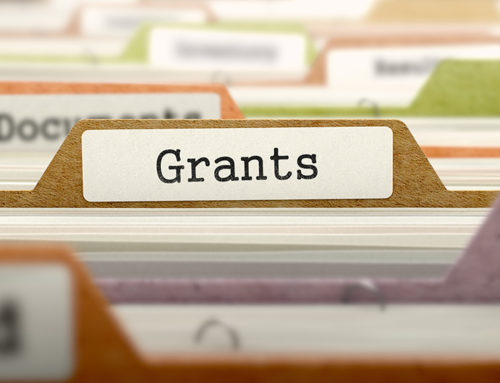
Often, the first step in getting a grant is a Letter of Inquiry (sometimes called a Letter of Intent) – or LOI, for short.
A Letter of Inquiry is a quick way to introduce your organization to a prospective funder and to open up a conversation about how a grant would make a positive impact on the community you’re serving and change lives.
If a funder likes your Letter of Inquiry, they’ll invite you to submit more details about what you would like them to fund.
That’s when you’ll be asked to provide detailed financial reports, budgets, and plans for executing your program and measuring your success.
But first, you must use your Letter of Inquiry to convince the funder that you’re a good fit, your missions are aligned, and working together, you could make great things happen.
On rare occasions, a funder is so convinced by a Letter of Inquiry that the fit is just right, and they’ll write you a check without additional information or supporting documents. Grant writing doesn’t get any better than that! But trust me when I say those are extremely rare instances.
Writing a Letter of Inquiry can be intimidating because you have to pack a lot of information into a small space – usually about three pages – and you have to frame your organization’s work and the specific program you’re seeking funding for in a way that piques the reviewer’s interest and compels them to want to give you money (or at least learn more).
Fortunately, when it comes to the structure of a Letter of Inquiry, you don’t have to guess at what is required.
Sometimes the funder will tell you exactly what they want, and they might even provide a sample.
If the funder doesn’t provide guidance, you can use our tried-and-true template for a stellar Letter of Inquiry!
A Letter of Inquiry is something of an art form, one you can master with practice and by understanding what funders want.
5 Tips to Getting Grants with an LOI

1. Take a moment to reflect. Before you start writing your Letter of Inquiry, take a moment to reflect on what you’re setting out to do – essentially, introduce your nonprofit.
As you do that, consider why the funder uses a Letter of Inquiry.
The Letter of Inquiry is part of the grantmaking process because it would be overwhelming and time-consuming for funders to review 15-page proposals from everyone seeking money.
That would simple take too long.
The Letter of Inquiry is a way for the funder to weed out submissions they don’t like and identify the ones they do like.
So think about the unique qualities of your program that might get you on the ‘keep’ pile instead of the ‘reject’ pile.
Put yourself in the shoes of the funder and imagine you’re reading stacks of Letter of Inquiries.
What kinds of details would jump out at you?
What would make the difference between rejecting the Letter of Inquiry or sending the organization through to the next round?
Jot down your thoughts so you can highlight these details when writing and stand out from the competition.
2. Treat a Letter of Inquiry like a first impression every time. When you meet someone for the first time, you make a special effort to put your best foot forward, especially if you want to cultivate a relationship with that person.
When you write a Letter of Inquiry, you want to put your best foot forward every single time, even if you already received money from the funder or know the foundation staff personally.
It’s almost like you’re an actor auditioning for a part in a play you really want.
Even if you have the experience and training necessary to play the part…
Even if you’ve researched the role and know you’re right for it…
Even if you’ve played the exact same role in this play for a theater company in another state and gotten rave reviews…
You still have to audition for the part. You still have to convince the director to cast you!
Never presume you’ll get funded a second or third time.
The reality is foundations often want to spread their resources around and give new organizations a chance.
Give the Letter of Inquiry your 110% best effort every time – no matter how convinced you are that you’re going to get the grant.
If you’re submitting a second time after being denied the first time, you’re getting a second chance to make a first impression. So make it count!
If you received feedback from the funder when you were denied, incorporate that feedback into the new Letter of Inquiry.
If you aren’t sure why you were denied, or if you were told you were denied just because there were too many Letter of Inquiries, think about ways you can make this Letter of Inquiry stronger.
 3. Give the funders what they want. Here are two hard-and-fast truths about grantmakers, when it comes to deciding who they want to fund:
3. Give the funders what they want. Here are two hard-and-fast truths about grantmakers, when it comes to deciding who they want to fund:
Truth #1: They want to be inspired by what the nonprofit does.
Truth #2: They want to partner with nonprofits who will help them achieve their goal of positively affecting change in the community issues they care about.
Once you wrap your brain around these truths about what funders want to accomplish with their giving, you can begin to shape the message in your Letter of Inquiry that’ll give them exactly what they want.
In describing the problem you’re looking to solve, do so in a way that evokes an emotional response. Often a single detail will accomplish this.
For example, let’s say you’re writing a Letter of Inquiry for a program to give suitcases, new clothing, school supplies, and other support to children in foster care. You note in the Letter of Inquiry that in the county your organization serves, foster children stay in the same home for a few months on average but they stay in the foster care system for 1 year on average. So most children are moving at least 3 times in 12 months.
That, alone, is powerful.
But go one step further.
What is it like for children caught in this system that requires them to pick up and move again and again?
What if you know children often carry their belongings from foster home to foster home in a garbage bag?
YOU may have seen this many times, and it barely registers anymore.
Yet, that image of a child going from home to home with their belongings in a garbage bag will be heart-shattering to the person reading your Letter of Inquiry.
People need to care about the problem you’re defining if they’re going to want to take action to fix it.
Funders want to read a Letter of Inquiry that raises their eyebrows and makes their heart pound.
They want to get excited about a new way to change lives.
You have the power to do that for them!

4. Knock their socks off! You want to leave the person who reads your Letter of Inquiry with a feeling of WOW!
You want to leave the person who reads your Letter of Inquiry wanting to know more, needing to know more, wanting to do more, wanting to get deeply involved in your work.
Think about the opportunities you have for a WOW moment.
Is there a specific life you changed that you can talk about in your Letter of Inquiry?
Is there a problem you can reveal that needs immediate attention but that no one is really paying attention to?
Is there a problem that can be immediately addressed while making a huge impact?
For example, a volunteer-run dental clinic learned through many years of providing dental services that quality dental care impacted a person’s overall health, including heart health.
By providing regular, quality dental care, the volunteer-run clinic eased pain associated with toothaches, but the clinic also extended people’s quality of life because of the connection between dental care and overall health.
A gift of a much-needed crown was not just the gift of pain relief in that tooth, it was the gift of better overall health, fewer trips to the doctor, fewer missed days of work, more enjoyment of life, and even a longer lifespan.
Who wouldn’t want to give someone back their joy and extend their life?
Here’s another example.
A dance troupe for kids from all types of backgrounds discovered many positives beyond dance among the students enrolled in the troupe – including a full point increase in their grade point average on average, fewer missed days of school, a more goal-oriented approach to post-high school options, and more scholarship opportunities (over half of which were unrelated to dance).
Give the gift of dance, and you might end up sending a kid to college on an academic scholarship!
5. Mind the basics. After working so hard to craft a compelling, heart-capturing, soul-stirring Letter of Inquiry, you don’t want to make a misstep that turns the reviewer off.
If the funder provides you with a form or template for your Letter of Inquiry, you’ll know exactly what they want.
If you’re on your own, here are some standards to keep in mind:
The Bottom Line

A strong, sparkling Letter of Inquiry has the power to get your foot in the door with funders and get grants.
The space limits of a Letter of Inquiry force you to boil down your pitch to the essence of who your organization is, what you do, and why your work matters.
By treating the Letter of Inquiry as the opportunity to inspire – and not just a form to fill out – you’ll stand out from the pack and find funders who want to give you money.
By showing them the impact they can make by investing in your nonprofit, you’ll motivate them to choose your organization to support.
Additional Resources
Grab our Letter of Inquiry template through the button below.






This is an excellent article. Well written.
I have learned a lot.
Thank you so very much for sharing your experience.
Thanks David! I’m glad this was helpful for you!
Thanks a lot. It is truly helpful.
WeCare is a non profit making organisation registered and based in kasama northern province of Zambia. The role of this organisation is to address the issues of early marriage, child prostitution, girls in the streets, teenage pregnancies, girls dropping out of school, alcohol and drug abuse, through sponsoring them to school, capacity building, good governance and offering life skills.
We’re really looking for a grant please help us reduce the high percentages of this vices.
Please send them your heart so that they know that someone cares for them
Hi Peter, sounds like a great organization. We don’t give out grants, but there are lots of articles on this blog where you can learn how to find grants.
I have included my name and email address several times to receive a template of your LOI but nothing has arrived. Will you make a special effort send it?
Arthur, check your spam folder. Sometimes our emails get stuck there.